There are a few things that I learnt during this hunt. One is that a story chooses you and won’t let you go until you tell its history. It can wait a long time but it will get its story told. Another is that once it gets hold it won’t let you go easily. And that a history isn’t always what you expected it to be. There will be surprises before it finally releases you
We are wandering a little way the high country of central Tasmania to the West Coast. This is the story of a little known mine and its smelter.
The Colebrook mine
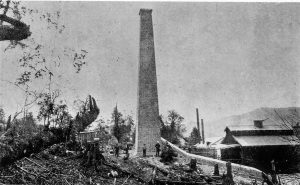
In 1991, I read Lou Rae’s wonderful history of the Emu Bay Railway. Inside was a very short story with a picture of a tall brick chimney in the forest and of a steep railway haulage up the heavily wooded and cloud shrouded Colebrook Hill.1
The smelter had failed. Lou suggested that a decimal point may have moved in a telegram to the directors. The copper content of the ore at Colebrook may have read 15% not 1.5%. He admitted that this was unlikely but the pictures and the story stuck in my mind.
Smelters can be interesting

For me smelters are almost magical. First, because they transform earth into metal. Another amazing thing is that they harness fire and molten liquids. It is like controlling a volcano. Even after decades working around furnaces of all kinds as a metallurgist, I still find them fascinating.
At the start of the 20th century copper smelters used blast furnaces built to a revolutionary American design. Copper ore from a mine, mixed with coke, was shovelled into the top of a big box built with a skin of water-cooled iron. Inside the mixed charge burnt and melted into liquid. Air for the reactions (the blast) was blown at pressure into the hot heart of the furnace. Molten copper matte and slag (the impurities) were poured from furnace. The slag was captured by small metal carts slag and dumped.
When the matte cooled it was carefully weighed and analysed. How much matte and how rich in copper were the two questions that determined whether a mine lived or died.
Colebrook starts gnawing
Late in 2017 I visited the West Coast Heritage Centre at Zeehan. Out the back with the rest of the big things was huge lump of iron, the furnace from the Colebrook mine. I enjoyed looking at this imposing old thing. I took a couple of pictures and moved on.

Then in early 2019 I visited Kenworthy’s Stamper Mill in Waratah with Ian. It was a noisy clunking rattling concoction of equipment. But sitting quietly in a corner was a small slag cart. It was from the Colebrook mine.
The fuse had been lit. It was time to get to the bottom of the unlikely history of the Colebrook smelter.
Colebrook Hill
Within two weeks Nic and I were at the foot of Colebrook Hill. Some quick research told us that the mine was at the top of the hill. But there was no mention of the smelter. Hopefully it wasn’t too far away. An old map showed a track to the mine and a recent map showed a road.

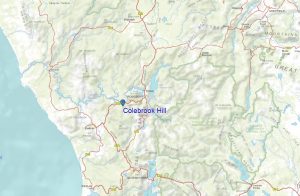
We headed into the bush. After a couple of misadventures, acres of blackberries and heading in the wrong direction, we found the road that we had meant to follow from the start.
We found some prospecting holes but not the mine. Crabbing across the steep face of Colebrook Hill finally took its toll and we descended to the manicured fairways of the Rosebery Golf Club. It was a typical first journey. More about understanding the lay of the land than discovery.
One solitary feature

Back home one look at the Tasmanian online map site, the List, showed that we’d just missed a massive excavation at the foot of Colebrook Hill. May be it was earthworks for the smelter.
The next weekend we were back in the thick bush behind the golf club. It was a huge cutting.
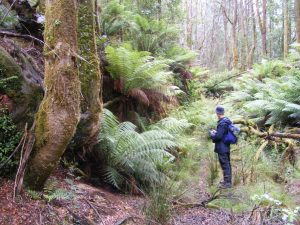
We searched it and the area without finding a single clue to what its purpose was. There should be rails, sleepers or dog spikes nearby if it was a haulage or a tramway. There would have been bits of machinery, levelled platforms or slag heap if it was from the smelter. Maybe the smelte was destroyed by more recent logging or was under the golf course. After all the course was in an ideal position between the bottom of the hill and the Emu Bay Railway. We were pretty despondent. There were more questions than answers.
Not even close
We didn’t have to wait long to have on answer. That afternoon we visited Shorty’s informal museum in Zeehan. It turned out that he had helped drag the furnace from Colebrook to the West Coast Heritage Centre years ago. We were kilometres away. It had been up behind the Rosebery Pistol Club, ‘you can’t miss it’. We went straight back for a quick look in the dying light of the day. All we found was thick scrub.

More research at home brought us to an aerial photograph from the late 1940s. There was the furnace building and the air blower house beside it. Back on the List again and the radar showed what looked like tramways, water races and the furnace area. That was fine in theory but we still had to find them in the bush.
A few more tricks to play

Nic, Ian and I returned in January 2020. We followed a rough road and then turned up hill into the bush. We were fresh and happily thrashed our way through the undergrowth. Near the top of a ridge we struck what looked like a well-built track and followed it. Within moments a massive iron pipe loomed out of the scrub. The smelter site mustn’t be far. I was excited.
A little further, and past another big piece of pipe, brought us onto an area that was unnaturally flat. Its east side ended at the top of a cliff. Below us was the furnace floor level.

This was one of those wonderful moments when it all paid off. We had found the smelter site. There were so many features that it was hard to decide what to look at first.
There was a road leading down, flat areas carved out for buildings, big concrete footings with large bolts, and discarded lumps of iron and brick. The few remains of the air blower house were perched a little above the furnace floor level. Then we went down to where the furnace had once stood.

In front was excavation for the furnace. Behind was a cascade of solidified slag. Some was frozen in the shape of a slag cart like the one at Waratah. It was a magnificent moment.
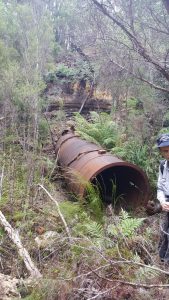
The furnace was gone but the area was littered with the everything that went around it. There were the rusty remains of the air pipes, the brick box which once received the molten liquids from the furnace and off-gas pipes. We scrabbled around for a while going in different directions until we’d exhausted ourselves. We left along the track – it was the tramway – that had brought us in.

I’d expected the tramway to turn left through a small gully towards Colebrook Hill. It didn’t. It clearly continued for another 100 metres where it stopped suddenly near power lines. Pushed into the bush was at a pile of large timbers that had been part of a substantial structure. It made no sense. We couldn’t find where the tramway continued.
It has been a great day. It was much more exciting than seeing the furnace in the well ordered surrounds of the Zeehan museum. There were still questions. Where did the tramway run and where was that tall brick chimney? Both were too big to easily miss.
More research
Ian scoured the radar images on List. Pretty soon he had the haulage and tramway worked out. There were even seemed to be the foundations of some of the houses. I combined Ian’s layout with the newspaper reports of the day. The site became clearer.
Finally, the chimney
We returned in March to give the site one last good shake. It was time to put it all together or to be proven wrong, again. The weather was typical West Coast liquid sunshine. A little bit of drizzle wasn’t going to stop us.
We walked along the highway and turned steeply uphill. This is where the List radar seemed to show a short haulage (also called an inclined tramway) that ran from the Emu Bay Railway to the tramway to the smelter. It was there. We followed it uphill and onto the end of a ridge. There was even a small section of formation that may have been for parking tram wagons.
On the end of the ridge was a levelled area that was exactly where the radar and the newspaper reports said it would be. This may have been where the machinery for the haulage stood. It explained the nearby big structural beams.
We looked for the general managers house, boarding house and butcher’s shop. We found likely spots but nothing definite. The spot where the radar seemed to show footing for buildings was a damp ferny hollow where we couldn’t even see our own feet.
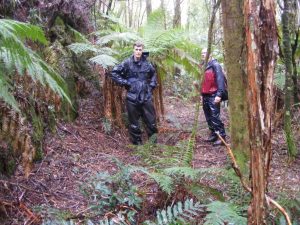
We followed the now familiar route of the tramway but this time to looking to see a turn towards Colebrook Hill. We expected to find it in a small saddle. There was nothing until we reached its far side. The broad formation was clear and also where it was cut into the side of the hills. We followed over a creek and then returned to go to the smelter site.
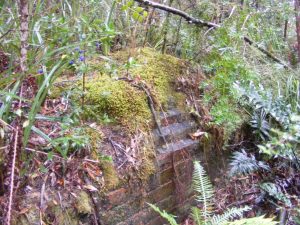
The first thing to find at the smelter site was the chimney. An original photo gave us a good idea where to look. It took moments to find. It was just the base and covered in ferns and scrub but it was in the right place and showed the distinctive stepped base.
We went back to our warm and dry accommodation knowing that we finally understood the layout of the site. The houses and mine haulage still eluded us but we were happy.
The haulage

Not happy enough though. The image of the haulage still haunted me. So I returned to find it. The long formation showed up on radar images and on old aerial photos but that didn’t mean it was easy to find. It took about 50 metres of wandering along roughly the right line to find it. The edges of the formation weren’t always obvious. It was covered in small stones used as bedding for the sleepers and rails.
The haulage just went up and up. Just like in the photo. It stopped near the top of the hill at some small workings linked by tracks around the side of the hill.

The site still has mysteries. One is how little remains. Rails, sleepers, dog spikes, the bricks from the chimney stack and furnace flue and the three tramway bridges are missing. The furnace buildings, present in the 1950s are gone. The site had been stripped bare. Luckily the earthworks of the tramways, haulages and smelter site still bear witness to the history that has been played out at the Colebrook mine.
And then it turned into a long history
The fascination with this site isn’t completely finished yet. Now that we understand the physical site we can explore the human history. Just as the furnace removed from its original site loses its context, so the site without the people who worked there is largely empty of meaning.
The stories of the people behind these holes in the ground and rusty iron emerged from the pages of old editions of the Examiner, North West Post and Mercury. That is when I was dragged into events and the lives of people from long ago. It takes a long time to dig through the rich history and emerge with these stories for you.
We will start with a poet-prospector and then pass through great waves of enthusiasm for the emerging mine. There will be ‘West Coast Royalty’, the ‘Broken Hillionaires’, who drove confidence to levels higher than the steep Colebrook Hill. Mine managers came and went. Feuds were fought. People dreamed of fortunes. Workers hoped for good jobs. They were all disappointed.
How do I tell you that story? It could go on for years. What to leave out?
I look forward to introducing readers to the first part of ‘The Colebrook Fiasco’.
Copyright Peter Brown 2020
[1] Lou Rae, The Emu Bay Railway, VDL Company to Pasminco, Mercury Walsh Moonah, 1991 p 141 – 143
[2] Harvey, John Henry H91.300/245 – State Library Victoria
[3] I S Gregory, Geological Report on Colebrook Prospect – SPL 302, Electrolytic Zinc Company of Australasia, 30/06/1958, Report No. 02_4676
Hi
Used to be able to take a 4WD right into the mine from the top of the last hill before you get to Williamsford
I don’t know if the tracks still there or not but the last time I think it was used was mid 80s when Rosebery mine did some drilling up there
I went in late eighties on a dirt bike but the road was a bit washed out I places
Didn’t do much up there except a quick look for some axinite crystals on a day trip
Cheers
Gday Peter,
I lived at Rosebery in the late 40s and all the 50s, in the later part I used to hunt out a lot of the old workings and tram lines.
The Colebrook was one of those mines.
When I last visited the smelter site the smelter was still there as well as the stump of the chimney.
I walked up to the mine from near the old Scout camp just past the golf links.
I have often wondered what happened to all the equipment that was scattered about at that time.
Well done in hunting it out after so much time and bush growth.
Cheers, Muz
Thanks Muz, it must have been a fascinating time to find all the old workings. And there are a lot of them too. We hope to visit more in the future, Peter
Great read
Went out there yesterday plan to go back and have another look around now.
Access too the old smelter area, is now a bit easier, as MMG have pushed in a few tracks, for drill sites, for a new tailings dam survey
Thanks for the information. I must revist the site